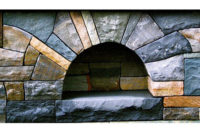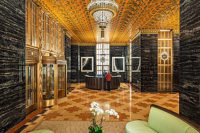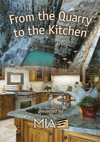For as long as three years now (depending on where
you’re located in the U.S.), most conversations among stone industry members
have begun and ended with a discussion of the economy - specifically how bad it
is and whether or not it is ever going to recover. And while we have a long
road ahead of us until we’re all the way back, all indications are that the
worst is behind us.
With this in mind, my interaction with
stone fabricators lately has been a little different than it was during the
depths of the recession - which seems to have been at or near the bottom from
late 2008 through the middle of 2009. These days, we’re talking more about the
craft of stoneworking and how fabricators are dealing with practical issues in
the shop. The economy hasn’t been forgotten, to be sure, but it no longer
dominates the conversation.
Maybe part of this is the fact
that everyone - including me - is just plain tired of talking about the
economy, since this mess certainly isn’t anything “new” anymore. Perhaps the
recession has caused more fabrication shop owners and managers to look inward
at their operations, and they are focusing more on increasing efficiency - even
if it means making an initial investment to do so. Whatever the reasons may be,
it is a welcome change.
Two prime examples of stone
fabricators showcasing their stoneworking techniques and investments can be
found in this issue of Stone World. In the first of these two “Fabricator Case
Studies,” we report on Innovative Surfaces of Hastings, MN (page 48), which has
made a number of investments in the latest technology, including a combination
bridge saw/waterjet and a laser layout-projection workstation. “The [bridge saw/waterjet]
has been great. We’ve had a lot better material utilization, and it has
relieved some time on our CNCs,” explained Bruce Akins, owner of Innovative
Surfaces. “We bought a laser [layout-projection workstation] at the same time,
so all slabs are photographed and laid out prior to being
cut.”
According to Akins, these investments have not only
benefitted the company within the shop, but also in its customer interaction.
“Our business is wholesale, so clients of our customers come to us after we’ve
taken photos of the slabs, and view the photos and slabs for layout approval.”
he said. “It’s nice to be able to view and manipulate the pieces prior to
cutting.”
Our second “Fabricator Case Study” in this issue
is South Shore Marble & Granite in Egg Harbor Township, NJ (page 58), and
this company has also made some major investments over the past year or so,
including a new CNC stoneworking center with a state-of-the-art pod management
system that had just been introduced to the marketplace at the time. “We
purchased that machine in late 2008, and it really changed the output of our
shop and made it more efficient. We found that we could do a lot more,” said
John DeBlasiis, owner of South Shore Marble & Granite. “Everything is set
up automatically. We don’t have to set up or attach hoses. I believe it is the
only one in the U.S.
It’s a workhorse; we use it all day long.”
DeBlasiis also
touted his investment in advanced digital templating technology, which he said
helps the company process complex jobs. “We are not doing the same thing over
and over again,” DeBlasiis said. “We are doing a lot of radius work and
inverted corners to create a custom look.”
While the
companies mentioned above are just two examples of fabrication shops that are
investing in new equipment, it is always invigorating to speak with firms that
have put this new technology into action. If you have recently made investments
in your shop, Stone World would love to hear about them, so feel free to E-mail
me at michael@stoneworld and let me know what is new at your shop.
Back to the “craft†of stoneworking
Looking for a reprint of this article?
From high-res PDFs to custom plaques, order your copy today!






